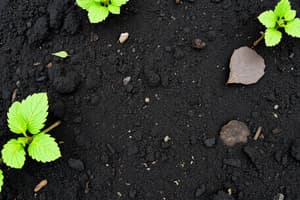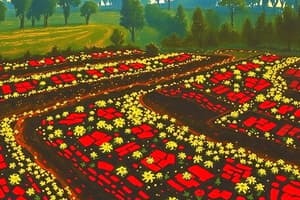Podcast
Questions and Answers
What is one of the main characteristics of black soil?
What is one of the main characteristics of black soil?
- Rich in organic matter
- Found primarily in the northern plains
- Swells when wet and shrinks when dry (correct)
- Deposited by rivers and streams
Which states are primarily covered by black soil?
Which states are primarily covered by black soil?
- Punjab and Haryana
- Odisha and Kerala
- Uttar Pradesh and Bihar
- Maharashtra and Madhya Pradesh (correct)
Which soil type is considered new alluvium in the Upper and Middle Ganga plain?
Which soil type is considered new alluvium in the Upper and Middle Ganga plain?
- Khadar (correct)
- Regur
- Bhangar
- Black Cotton Soil
Alluvial soils in the eastern parts of India are typically found in which area?
Alluvial soils in the eastern parts of India are typically found in which area?
What nutrients do black soils generally lack?
What nutrients do black soils generally lack?
What color range do alluvial soils typically exhibit?
What color range do alluvial soils typically exhibit?
Which of the following best describes the process of alluvial soil formation?
Which of the following best describes the process of alluvial soil formation?
What is a characteristic feature of Bhangar soil?
What is a characteristic feature of Bhangar soil?
What type of crops are primarily affected by the weather conditions caused by western disturbances?
What type of crops are primarily affected by the weather conditions caused by western disturbances?
Which practice involves loosening soil to enhance aeration in preparation for planting crops?
Which practice involves loosening soil to enhance aeration in preparation for planting crops?
What is the primary purpose of applying manure to the soil?
What is the primary purpose of applying manure to the soil?
Which of the following describes the practice of Jhumming?
Which of the following describes the practice of Jhumming?
What characterizes the Terai region's soil composition?
What characterizes the Terai region's soil composition?
What is one of the main methods used to maintain soil fertility, aside from adding manure?
What is one of the main methods used to maintain soil fertility, aside from adding manure?
Which of the following is NOT a common agricultural practice mentioned?
Which of the following is NOT a common agricultural practice mentioned?
Which of the following is a feature of alluvial plains?
Which of the following is a feature of alluvial plains?
What is a key characteristic of sustainable agriculture?
What is a key characteristic of sustainable agriculture?
Which of the following practices allows farmers to temporarily cultivate a plot of land before moving on due to soil exhaustion?
Which of the following practices allows farmers to temporarily cultivate a plot of land before moving on due to soil exhaustion?
What type of crops are typically grown in the Terai region of India?
What type of crops are typically grown in the Terai region of India?
What is the purpose of harvesting in agricultural practices?
What is the purpose of harvesting in agricultural practices?
What is the primary role of weeding in agriculture?
What is the primary role of weeding in agriculture?
What is a major concern related to irrigation practices in agriculture?
What is a major concern related to irrigation practices in agriculture?
What type of agricultural method is described by using forest land and adding ashes to the soil?
What type of agricultural method is described by using forest land and adding ashes to the soil?
Flashcards are hidden until you start studying
Study Notes
Black Soil
- Black soil found in Deccan Plateau, covering parts of Maharashtra, Madhya Pradesh, Gujarat, Andhra Pradesh, and Tamil Nadu.
- Deeper in upper Godavari and Krishna, and northwestern Deccan Plateau.
- Also called Regur Soil or Black Cotton Soil.
- Clayey, deep, and impermeable.
- Swelling and stickiness when wet, shrinking and cracking when dry.
- Retains moisture due to slow absorption and loss, aiding rain-fed crops during dry seasons.
- Rich in lime, iron, magnesia, and alumina.
- Contains potash but lacks phosphorus, nitrogen, and organic matter.
- Color ranges from deep black to grey.
Alluvial Soils
- Widespread in northern plains and river valleys.
- Covers about 40% of India's area.
- Deposited by rivers and streams.
- Found in Rajasthan plains, east coast deltas, and river valleys.
- Varies from sandy loam to clay.
- Rich in potash but poor in phosphorus.
- Two types in Upper and Middle Ganga plain: Khadar (new alluvium) and Bhangar (older alluvium).
- Khadar enriched by annual floods depositing fine silts.
- Both Khadar and Bhangar contain calcareous concretions (Kankars).
- More loamy and clayey in lower and middle Ganga plain and Brahmaputra valley.
- Sand content decreases from west to east.
- Color varies from light grey to ash grey depending on deposition depth, texture, and maturity.
- Intensively cultivated.
Rabi Crops
- Western disturbances bring rainfall during winter, beneficial for rabi crops (wheat, barley, mustard, gram, lentil).
Agricultural Practices
- Soil Preparation: Plowing, manuring, and leveling.
- Plowing loosens soil and allows air penetration.
- Manure improves nutrient quality and fertility.
- Leveling distributes soil evenly.
- Sowing: Good quality seeds dispersed into prepared soil.
- Manually or using machines.
- Some seeds might need seedling stage before sowing.
- Manuring: Applying organic (cow dung) or artificial (Ammonium Nitrate) manure for high yield.
- Other methods like crop rotation, leguminous plants, vermicompost maintain soil fertility.
- Organic practices are more sustainable.
- Irrigation: Providing water supply from lakes, rivers, wells, ponds.
- Careful irrigation avoids crop damage.
- Weeding: Removing unwanted plants manually or using weedicides.
- Harvesting: Cutting and gathering mature crops, manually or using machines.
- Storage: Storing harvested produce in warehouses for transportation to markets.
- Grains separated from chaff and packed properly.
Tribal Inhabitants
- Various ethnic tribal communities inhabit Arunachal Himalayas.
- Prominent communities from west to east: Monpa, Daffla, Abor, Mishmi, Nishi, and Nagas.
- Most practice Jhumming (shifting or slash-and-burn cultivation).
- Region is rich in biodiversity preserved by indigenous communities.
About Shifting Cultivation
- Subsistence farming with temporary cultivation on a plot until soil exhaustion.
- Practised in northeastern India, including Assam, Manipur, Mizoram, Nagaland.
- Also known as Jhum Kheti, Slash and burn agriculture, fire-fallow cultivation.
- Forest land cleared, ashes added to soil.
- Cultivated areas are small.
- Short cultivation periods alternate with long fallow periods.
- Field rotation practiced instead of crop rotation.
Shifting Cultivation and Regions
- Jhoom: North-eastern India
- Vevar and Dahiyaar: Madhya Pradesh
- Deepa: Madhya Pradesh
- Zara and Erka: Southern States
- Batra: South-eastern Rajasthan
- Podu: Andhra Pradesh
- Kumari: Western Ghats of Kerala
- Kaman: Odisha
The Tarai (Terai)
- 10-20 km wide strip south of Bhabar, running parallel.
- Underground streams from Bhabar re-emerge.
- More pronounced in the east due to higher rainfall.
- Thickly forested region with diverse wildlife.
- Jim Corbett National Park (Uttarakhand) and Kaziranga National Park (Assam) are situated in the Tarai.
The Terai Marshes
- Ill-drained and damp (marshy).
- Silty soil rich in nitrogen and organic matter, deficient in phosphate.
- Most Terai land converted to agricultural land, producing sugarcane, rice, and wheat.
Alluvial Plains
- Situated south of the Tarai region.
- Comprises:
- Bhangar (old alluvial deposits)
- Khadar (new alluvial deposits)
- Exhibits fluvial erosional and depositional landforms (sandbars, meanders, ox-bow lakes, braided channels).
Sustainable Agriculture
- Practices and principles focused on environmental stewardship, economic profitability, and social equity.
- Examples: crop switching, organic farming, community supported agriculture.
- Techniques include crop rotation, intercropping, organic fertilization, and pest management.
- Requires high initial investment in infrastructure, equipment, and inputs.
Fotu (Photu) La & Namika La
- Two high mountain passes between Leh and Kargil.
- Fotu (Photu) La: 4,108 m
- Namika La: 3,700 m
Studying That Suits You
Use AI to generate personalized quizzes and flashcards to suit your learning preferences.




